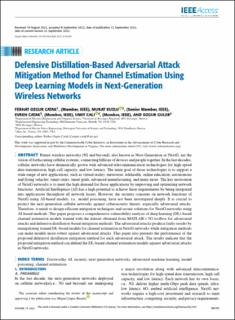| dc.contributor.author | Catak, Ferhat Özgur | |
| dc.contributor.author | Kuzlu, Murat | |
| dc.contributor.author | Catak, Evren | |
| dc.contributor.author | Cali, Umit | |
| dc.contributor.author | Guler, Ozgur | |
| dc.date.accessioned | 2022-10-21T11:56:56Z | |
| dc.date.available | 2022-10-21T11:56:56Z | |
| dc.date.created | 2022-09-14T08:42:51Z | |
| dc.date.issued | 2022-09 | |
| dc.identifier.citation | Catak, F.O., Kuzlu, M., Catak, E., Cali, U., Guler, O. (2022) Defensive Distillation-Based Adversarial Attack Mitigation Method for Channel Estimation Using Deep Learning Models in Next-Generation Wireless Networks, 10 | en_US |
| dc.identifier.issn | 2169-3536 | |
| dc.identifier.uri | https://hdl.handle.net/11250/3027581 | |
| dc.description.abstract | Future wireless networks (5G and beyond), also known as Next Generation or NextG, are the vision of forthcoming cellular systems, connecting billions of devices and people together. In the last decades, cellular networks have dramatically grown with advanced telecommunication technologies for high-speed data transmission, high cell capacity, and low latency. The main goal of those technologies is to support a wide range of new applications, such as virtual reality, metaverse, telehealth, online education, autonomous and flying vehicles, smart cities, smart grids, advanced manufacturing, and many more. The key motivation of NextG networks is to meet the high demand for those applications by improving and optimizing network functions. Artificial Intelligence (AI) has a high potential to achieve these requirements by being integrated into applications throughout all network layers. However, the security concerns on network functions of NextG using AI-based models, i.e., model poisoning, have not been investigated deeply. It is crucial to protect the next-generation cellular networks against cybersecurity threats, especially adversarial attacks. Therefore, it needs to design efficient mitigation techniques and secure solutions for NextG networks using AI-based methods. This paper proposes a comprehensive vulnerability analysis of deep learning (DL)-based channel estimation models trained with the dataset obtained from MATLAB’s 5G toolbox for adversarial attacks and defensive distillation-based mitigation methods. The adversarial attacks produce faulty results by manipulating trained DL-based models for channel estimation in NextG networks while mitigation methods can make models more robust against adversarial attacks. This paper also presents the performance of the proposed defensive distillation mitigation method for each adversarial attack. The results indicate that the proposed mitigation method can defend the DL-based channel estimation models against adversarial attacks in NextG networks. | en_US |
| dc.language.iso | eng | en_US |
| dc.publisher | IEEE (Institute of Electrical and Electronics Engineers) | en_US |
| dc.rights | Navngivelse 4.0 Internasjonal | * |
| dc.rights.uri | http://creativecommons.org/licenses/by/4.0/deed.no | * |
| dc.subject | trådløst nettverk | en_US |
| dc.subject | 5G | en_US |
| dc.subject | NextG | en_US |
| dc.subject | informasjonssikkerhet | en_US |
| dc.title | Defensive Distillation-based Adversarial Attack Mitigation Method for Channel Estimation using Deep Learning Models in Next-Generation Wireless Networks | en_US |
| dc.type | Peer reviewed | en_US |
| dc.type | Journal article | en_US |
| dc.description.version | publishedVersion | en_US |
| dc.subject.nsi | VDP::Teknologi: 500::Informasjons- og kommunikasjonsteknologi: 550 | en_US |
| dc.source.volume | 10 | en_US |
| dc.source.journal | IEEE Access | en_US |
| dc.identifier.doi | 10.1109/ACCESS.2022.3206385 | |
| dc.identifier.cristin | 2051491 | |
| cristin.ispublished | true | |
| cristin.fulltext | original | |
| cristin.qualitycode | 1 | |

